Check out this video on Building strength and power!
When you’re lifting weights, the amount of time you take between sets can influence how your muscles will adapt. And there are lots of considerations for choosing how much rest you take, including the phase of the fight plan you’re in, your training status (beginners generally require more rest than intermediate and advanced fighters), the goal of training, and the relative load lifted. Below is a simple figure that matches the appropriate rest period length with your resistance training goal.

Generally, you need 2 to 5 minutes of rest when your goal is strength training and power training. Recall that the goal here, especially with power training, is to allow enough time to resynthesize a good supply of phosphocreatine (PCr) in your type II muscles before the next set, which allows your muscle to perform at a very high intensity. This can take up to five minutes. If you don’t take enough rest here, the build-up of metabolites and acidity, and the depleted PCr pool will prevent your muscle from generating enough force to encourage strength and power development. Essentially you want to feel pretty good before the next set and be able to execute the movement with perfect technique.
On the other hand, when your goal is hypertrophic training, you want to cut the rest down to somewhere in between 30 to 90 seconds. This encourages a rather large build-up of metabolites and muscle acidity that act to stimulate the release of anabolic hormones, which trigger protein synthesis, which makes your muscles grow bigger. It also means that you’ll be feeling rather fatigued before your next set, and that’s normal with this type of training. It also means that your force output will fall across your sets due to inadequate recovery – you’ll either have to drop your weight to hit your desired repetition range, or drop your reps.
Read: Essential resistance training exercises for MMA fighters
And finally, when your goal is the development of muscle endurance, you want even less rest. This encourages the development of the oxidative potential of your slow-twitch muscle fibers, which are important for muscle endurance.
A well-rounded resistance training program for an MMA fighter should focus on the development muscle endurance, muscle strength, and muscle power, and to a lesser extent, muscular hypertrophy.
Read: How to order resistance exercises in a workout
And just like training load, repetitions, and training volume, the amount of rest you take between sets should be manipulated across your fight plan. This might involve manipulating your rest periods on monthly, weekly, and perhaps a daily basis, and this should be done according to the phase of the fight plan that you’re in. For example, some phases of your fight plan will call for a few weeks of muscle endurance training featuring 2-3 sets and a rest period in the 30 s range, followed by a few weeks of hypertrophy training featuring 3-6 sets and rest periods in the 30 s to 90 s range. Knowing when and by how much to manipulate training volume takes knowledge and experience. If you’re looking for help, consider The MMA Training Bible’s training programs, which removes a lot of the guesswork. We’ll take you through the step-by-step process to create your own plan, and we’ll provide guidance on everything from organizing your fight calendar to programming recovery workouts.
So that’s it for this article, and our series on resistance training. I hope you now have a good understanding of how to choose the correct rest, and everything else related to building muscle endurance, strength and power.
Take care,
Dr. Gillis

Leave a Reply